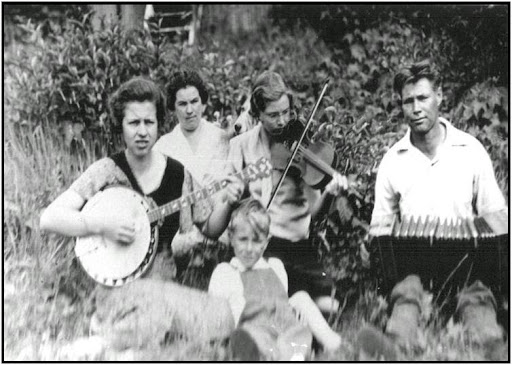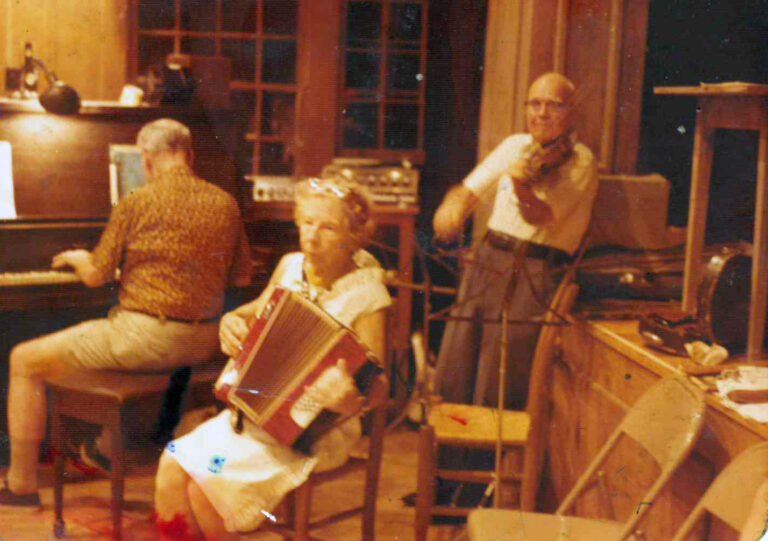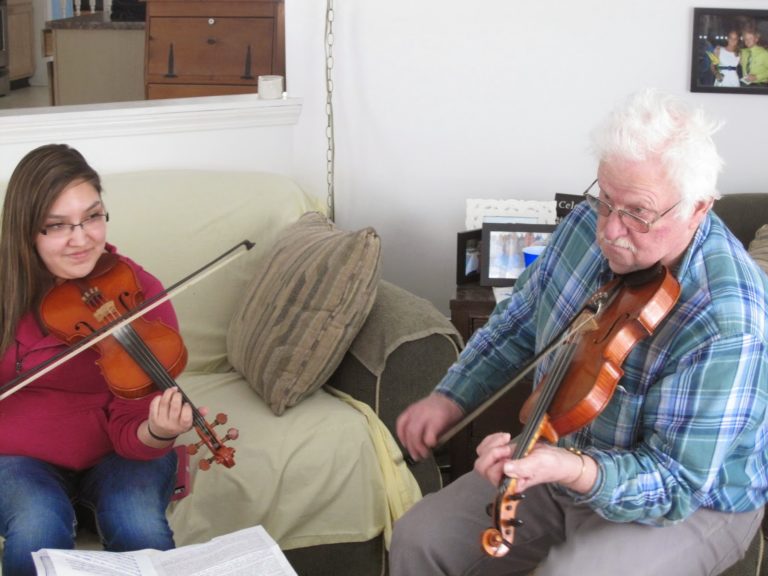For the past year, I have had a growing conviction about the state of Michigan fiddling. Once prior I forged a manifesto similar to this but never used it. In this manifesto I use ?Michigan Traditional Style? and ?Michigan Old Time? interchangeably.
This manifesto is intended to spur thought and discussion. It’s me finally saying what I’ve been thinking for some time now. It m ay be easy to disagree with it. It is intended as a spur to thought, not a hindrance to friendship.
Also, I don’t think I know of anyone of Michigan’s traditional style fiddlers who I don’t appreciate for their efforts to support and promote the style, or who I don’t like as a person. Thanks so much for great times, everyone!
In 1923 and 1924, respectively, Jasper “Jep” Bisbee and Colonel John A. Pattee became the first two Michigan fiddlers to commercially record. Being born in 1843 and 1844, the two represented a significant link with the past of Michigan’s fiddling tradition. Both recorded the tune Mony Musk, which is the most commonly referenced tune in accounts of the immigration to Michigan of the 1830s and 1840s. The two fiddlers had remarkably different personalities. Bisbee played elaborate, technical, and likely pre-determined variations in a steady rhythm. It had the even, consistent spacing that is associated to some degree with the southern lower peninsula of Michigan, today. Pattee, on the other hand, played with aggression, verve, and what by listening I hear as a vivacious showmanship. His variations also have a much more improvisatory feel.
I tend to like Pattee, but both fiddlers were brilliant for their time period. They also had different backgrounds and purposes. Pattee was a stage and radio fiddler, though no doubt he also drew bread and butter from dances; he even called a dance while he played on one of his recordings. Pattee had a significant feel for showmanship and pleasing audiences. Bisbee on the other hand was a dance fiddler and likely had a much more reserved and careful personality than Pattee’s.
As stated, two fiddlers recorded in the early 1920s. They were both about 80 years old when they recorded. At that time and especially prior in the lives of Bisbee and Pattee, fiddling in Michigan looked much different than it does today; it was comprised of all ages. Children, adolescents, young adults, middle aged adults, and the elderly were all playing fiddle music in Michigan. At the same time, ethnicities and cultures were mixing, creating creolizations of music that were bringing new sounds to old tunes. Creolization is often the source of some of the most interesting musical expressions.
At this period, Michigan fiddling and Ontario fiddling likely had much in common. Both areas had significant agrarian and lumber industry activity over the lives of Bisbee and Pattee, as well as interaction across rivers and in the thriving Great Lakes shipping scene. Immigration also helped insure a strong connection. Traveling around Michigan and Ontario at this time, it would have arguably been difficult or impossible to tell whether one was in Michigan or Ontario by listening to fiddling. One would have run into similar ethnic fiddling styles and similar developing creolizations. Similar repertoire also would have been encountered.
Reading accounts of the dance halls and house party scenes of those days, it is apparent that the youth, both dancers and musicians, were performing with verve and energy. In the dance halls that began to gain importance as automobiles became more accessible, fist fights and the drinking of liquor were by no means rare among the young males. People wanted to have a good time, and for young males, that often included carousing and rowdy behavior. The youth had energy and were looking for an experience that could express it.
Fast forward to the year 2012. Traditional Michigan fiddling is nearly gone, and few people have interest in it, least of all the youth. On the other hand, traditional Ontario fiddling is thriving and producing some of the best examples of fiddle playing in the world, with the youth of Ontario flocking to participate. Today, what are called Michigan Traditional Style Fiddling and Ontario Style Fiddling are distinctly separate and immediately recognizable to a familiar ear.
What happened?
This is one of the most intriguing questions I know. I have written quite a lot on this topic in the past and different aspects of the why could be teased out at great length. Industry and popular media in the 20th century have something to do with it, I believe. Yet the main reason for this difference I believe to be the following:
In Ontario, young people kept fiddling in traditional Ontario style.
In Michigan, young people stopped fiddling in traditional Michigan style.
This cessation of young fiddling in Michigan style occurred sometime around 1950, give or take. But the exact time or the reasons for it don’t matter for the purpose of this manifesto.
Sometime around the 1970s, the national folk revival really hit Michigan in its localized form. What took place was the formation of the Michigan fiddlers associations. The organization(s) really helped Michigan preserve a lot of its fiddling history and deserve to be praised for their efforts. With the folk revival came folklorists. Folklorists love older people and see them as preserving older styles; that’s what folklorists are interested in. The fiddlers association really fit the bill, then, and only continued to fit the bill better and better as time went on. Lots of folks recorded people in this era, and when it comes to Michigan fiddling, the bulk of fieldwork available to us comes from the decades of 1970-1990. Since then, efforts to promote and protect Michigan traditional style fiddling have derived from this era’s fiddling culture and fieldwork. The fieldwork is very useful. In fact, if it were not for the invaluable recordings, I would know very little about the actual playing styles of many Michigan fiddlers. That is huge thing.
Of course, there is a problem. Essentially, the folklorists were preserving older fiddlers. The fiddlers were generally elderly, and when they played for dancing, they were often playing for older dancers. Michigan Fiddle Style as it is now perceived is based on the physical and artistic exertions of the older generations, in a style that ceased to be influenced consistently by young people decades prior. Some of these old fiddlers helped promote an increasingly restrictive, protective, and localized idea of what Michigan fiddling was and is. Now, Michigan Traditional Style fiddling is often seen as even more restrictive than the early field recordings demonstrate that it was, and it has become exceedingly localized in some areas to refer only to a specific region and way of playing within Michigan. This way of playing is often associated with only one or a few individual old fiddlers out of what was really a selection of scores if not hundreds with different styles of playing. What’s more complicated, the few fiddlers that got held up as icons were not necessarily by any means the most skilled fiddlers in the state or region. That does not mean that they are not extremely valuable and worth preserving. At the same time, as far as what is held up today as traditional Michigan Style Fiddling ? Colonel John A. Pattee, born in 1844, might have been bored with it.
I love older fiddlers and value them highly, so please don’t think I am ragging on them. But as a folklorist this is a problem. It is a bigger and a much more personal problem for me as a fiddler. It is the biggest problem of all for me as someone trying to promote Michigan fiddling to my generation and people younger than me. Why is that I, as a professional fiddler dedicated to fiddling, have had to consider that in order to play what people think of as “Michigan Style Fiddling,” I have to play with little ornamentation, little verve, at slow tempos suitable to the dance of older folks (young people in the UP dance a schottisch with energy to this day)? Why do I feel like I have to play boring to be Michigan style? I don’t mean that to cause offense, but it is a critical question to me. I have listened to a wide cross section of Michigan fiddlers from previous generations. They were doing some interesting and exciting stuff. I want to represent that.
I play for dances and I love to play for dances. Of course, playing for old dancers is not nearly as fun as the mixed age crowds I generally play for. I love to play Michigan repertoire at these dances. But make no mistake, I am not going to play them in the way typically — and as a folklorist I believe erroneously ? associated with Michigan Old Time Fiddling. And when I think of fiddlers like Walter Bartolomay, Colonel John A. Pattee, Brian Belleau, Coleman Trudeau, Dick Gravell, Helen Gross, and Ray Shepherd, I’m confident that I’m honoring Michigan fiddle traditions by allowing myself freedom to pursue my artistic tastes. I am innovating and playing Michigan Old Time both. The only way to accept that is to see Michigan Old Time, not as a dead tradition (in the way that Latin is a dead language) but as a living tradition.
Ontario Old Time didn’t stop innovating, and to some degree, creolizing. It didn’t shut itself off and try to preserve its elderly form. It allowed its young people to be young people and its older generations people to be themselves as well. Consequently, as an artistic expression, it has spirit and vitality. On the contrary, Michigan Old Time as an artistic expression is struggling.
Michigan Style Fiddling does not have to continue on its current path. In fact, I am confident it can be revitalized on a scale large enough to perpetuate itself. But in order to do so, it has to regain its sense of artistic authenticity. It has to become a voice for young people. Fiddling can do this; I have experienced it and I see it all the time in young people. Teaching in the Bluegrass, Old Time, and Country Music program at East Tennessee State University, I see scores of young people riveted and inspired by traditional music and driven to express themselves through it. I see the same across Canada, even just a handful of miles away from the border of Michigan.
And Michigan is full of young fiddlers. I think fiddle playing in Michigan is healthier than it has been in decades. Our state boasts some fantastic young fiddlers ? such as Grammy-winning Jeremy Kittle ? and there are fiddle clubs in the schools that have inspired similar clubs elsewhere. I recently spoke with a young, dynamic, skilled fiddler from Michigan who came to Tennessee to study Bluegrass. I sat and taught him a Michigan tune a few days ago and told him about Michigan style fiddling, hoping to get him interested. He grew up fiddling in Bluegrass circles across Michigan, and yet he wasn’t familiar with Michigan old-time fiddling. These many vibrant young people in Michigan aren’t playing Michigan Traditional Style fiddling because they are looking for something that inspires them and allows them to express themselves. Living traditions allow for this.
Michigan Old Time Fiddling can be inspiring, but not as it is generally presented. If I was going to try to get a young person interested in Michigan old time fiddling, I know of nowhere to send them ? it would not be to the organizations or the jamborees, that’s for sure, unless they are interested in studying folklore and could look past the generally low-skilled presentations of Michigan fiddling (some people are good players, but the standard of fiddling these days is high). I’m not trying to say everyone should be a brilliant, professional level fiddler or should be innovating or at least creolizing the music. But the Michigan Old Time tradition, to be alive, must allow for this. I don’t want to offend anyone, and I support efforts to preserve Michigan fiddle history. As a folklorist and a historian, I like that stuff and find it valuable. But I play the fiddle for passion and art.
Without young people in Michigan seeing Michigan Old Time as an artistic expression that they can use to speak, that will be exciting, that will be meaningful, that will be fun, that will connect with their souls, then Michigan fiddle style will only be preserved by few folklorists. Not many young people with simply try to preserve a way of life that they didn’t experience. I believe that Michigan Old Time fiddling can be inspiring. I perform it regularly and I attempt to do so in a way that connects with myself and the audience. I believe that unless young people see Michigan Style Fiddling being performed with a high level of artistic skill and artistic authenticity, then it will continue to struggle and shrink. In Ontario, there are many highly skilled, artistic fiddlers for kids and adults alike to look up to. I owe my abilities to the fact that I had people like Pierre Schryer to look up to. Michigan needs young, skilled performers to take on Michigan style and use it to speak their own hearts and meet their own artistic needs. Without that, young people will continue to look elsewhere for traditions that do allow them to be themselves. This goes for those performing on stage and for dances, and for those who just want to get together with friends and have a tune.
I am 26 years old and I’m a Michigan Old Time fiddler in what I believe to be an authentic style for a fiddler from where I’m from and with my experiences. I believe it is a style that honors the history and traditions of Michigan and my own life.
I am a young fiddler and I play Traditional Michigan Style Fiddle.
I syncopate. I alter my timing. I use many different ornaments. I like tempos that young people would dance to, but when not playing for dancing, I also play at tempos so audiences and young people will be excited listening. I use variations and improvisation. I creolize. I innovate. I push myself and don’t want to hold back. I honor those who came before me, but I can do things beyond. I love the tunes. I play Michigan repertoire, and I have my own settings and arrangements. I do not want to play like an 80 year old fiddler of moderate skill, though I value what they have passed on to me. I learn from older generations, but I speak for myself, and I pursue more.
I am a young fiddler and I play Traditional Michigan Style Fiddle. It speaks to me, and I use it to speak.
This is my manifesto.
Again, I am so thankfully for everyone who has worked to preserve Michigan style music and for your kindness and encouragement to me. Please consider this manifesto as a spur to thought and not a hindrance to friendship.
Thank you,
Trae McMaken



